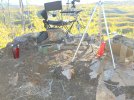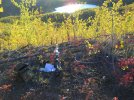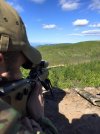The difference in the two situations is the accuracy of the zero becomes more and more effected by environmental and by chasing noise within the zeroing process.
Doing the 100 then predial presents the situation with fewer possible variables. Especially when people try to zero rifles by chasing around 3 shot groups, the larger your theoretical cone for zeroing the greater possibility you're not exactly centered.
I think that I've seen you say several times about "Not" zeroing @ ranges over 100…..
The difference in the two situations is the accuracy of the zero becomes more and more effected by environmental and by chasing noise within the zeroing process
I can agree……somewhat! Here's what I do, tell me where I'm in error!
I do my initial load development @ 100 yards. If the load looks promising…..I then shoot that load at 300 yards (my home range maximum). In my mind, this will "help" determine the loads long range potential! I also zero @ 300…..a distance decided upon long before we purchased a range finder.
You mentioned, environmental as a zeroing issue. With having a backyard range…..We have the opportunity to do our range work, load development and zeroing during absolute perfect conditions. If less than perfect conditions….we have dozens of other things to do around the place! In my thought process, "IF" we can shoot good groups at 300 and adjust accordingly, I think that there will be "less" error at longer ranges than with the 100 yard zero! I also think that with the 300 yard zero…..it helps minimize/negate some of the potential error in the dial-up!
Having a home range can fairly closely replicate our anticipated hunting conditions…..temperatures, elavation, and barometric pressure!
We got very comfortable with this system, by using it for nearly 30 years. So, why not continue to use a zero we were comfortable with…..then use the range finder and dial-up for the longer shots. And as mentioned, it affords us the ability to use a "zero stop" turret to take us beyond a range at which we would shoot big game!
Not trying to be argumentative…..just trying to understand theoretical negatives with my system!
Thanking you in advance for your attempts to enlighten me! memtb




